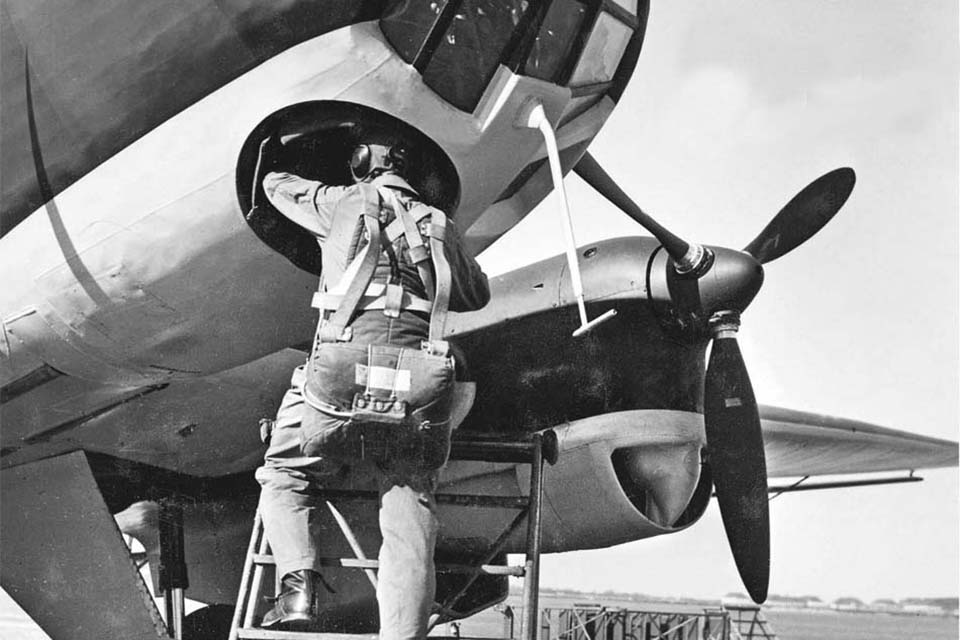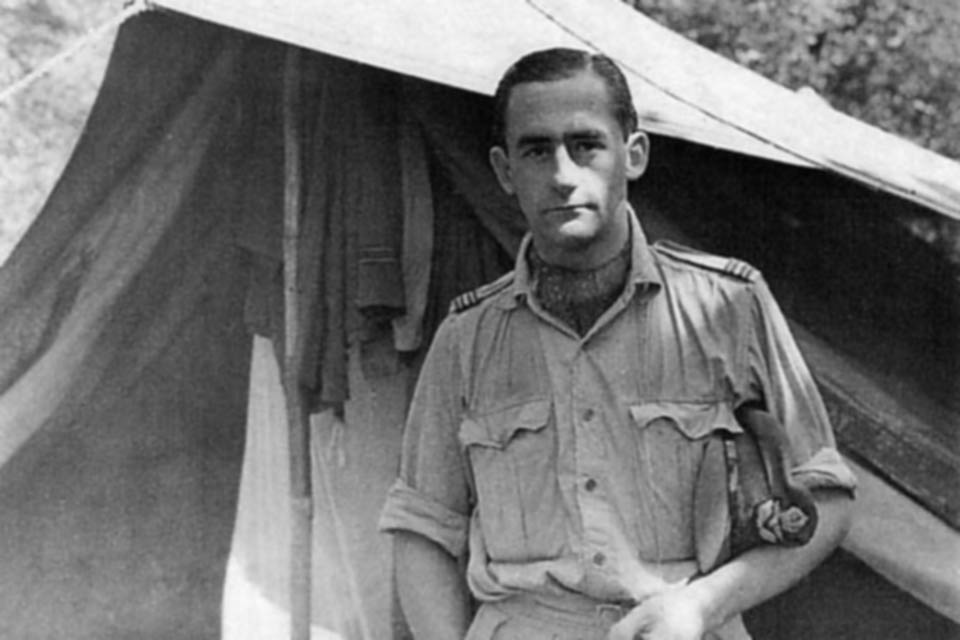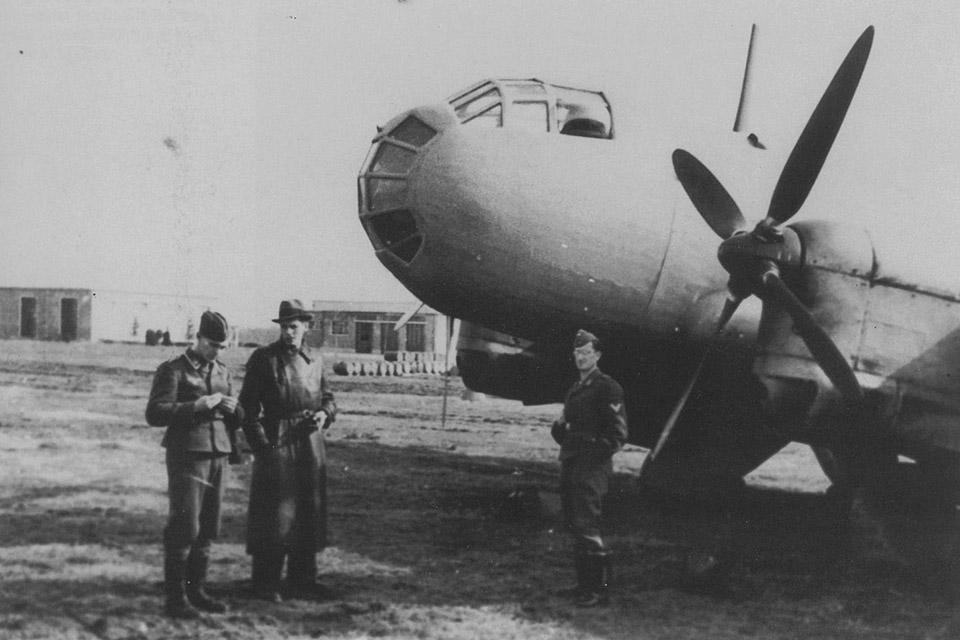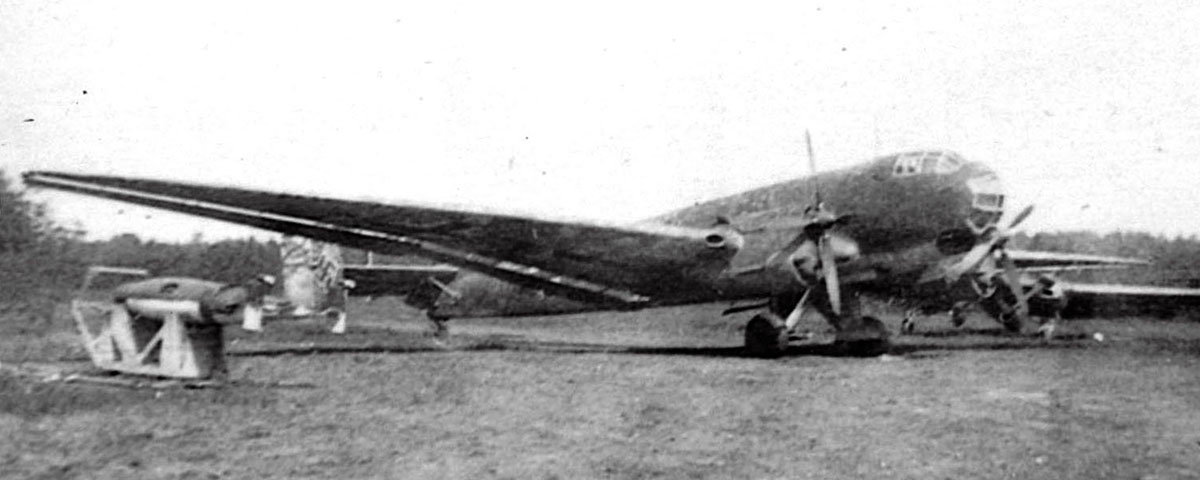A Russian prince piloting a modified Spitfire for the RAF targeted a Junkers JU-86R during World War II’s highest aerial combat
In the summer of 1940, a challenging new opponent appeared in the skies over Britain. A prototype German reconnaissance airplane, it flew at a leisurely 200 mph but could climb to an altitude of 41,000 feet—well out of reach of the Royal Air Force’s best interceptor, the Supermarine Spitfire. The Junkers Ju-86P flew so high that the Germans considered defensive armament unnecessary. These diesel-powered recon planes made sporadic overflights of Britain, but by early 1941 they had been transferred to Eastern Europe to conduct covert operations over the Soviet Union in preparation for Operation Barbarossa, Germany’s invasion of June 1941. By the late summer of 1942, however, they were back over Britain, this time carrying bombs. The high-flying Junkers’ reappearance in the West, and their deployment over Egypt at that critical juncture in the war, had been prompted by two very different imperatives: propaganda-driven revenge over England, and strategic reconnaissance in the Middle East.
The high-altitude Ju-86 variants had their beginnings in an innovative but ultimately mediocre twin-engine bomber of the mid-1930s. That aircraft’s technical distinction lay in its 600-hp Junkers Jumo diesel engines, which Hugo Junkers spent years developing. Diesel power plants offered excellent fuel economy but were heavy, resulting in a very poor power-to-weight ratio in aviation applications. To solve that problem, Junkers created a two-stroke design that used opposed pistons in a single bore. His weight-saving measures made it possible to produce diesel engines only marginally heavier than their gasoline-powered equivalents.
Despite Junkers’ innovative design, the new diesel was the primary reason for the Ju-86’s lackluster performance during its introduction to combat in the Spanish Civil War. The diesel power plant proved to be unreliable, requiring careful maintenance to avoid seizing pistons and exhaust port erosion. As a result, most Ju-86s had been relegated to training units by the time World War II began.
Junkers had also been at the forefront of high-altitude research during the 1930s, building two experimental aircraft in an effort to develop pressurized cabins. In addition, by 1939 the company was developing a high-altitude version of the Jumo 205 diesel engine, the 900-hp Jumo 207A equipped with two superchargers.
Seeking a market opportunity for their now obsolescent bomber airframes, in September 1939 Junkers proposed to the German Air Ministry a modification of the basic Ju-86D bomber for use at high altitude. The prototype featured the new diesels driving three-blade propellers and the military world’s first pressurized cockpit. The self-contained cockpit seated a two-man crew and maintained pressure equivalent to that at an altitude of 10,000 feet. Bleed air from the port engine’s supercharger was used for pressurization, and warm air ducted between the cockpit’s sandwiched windows prevented their frosting over at altitude.

In early 1940, two prototypes flew to test the new systems. They were soon joined by a third version equipped with wings extended by 10 feet. With its nearly 84-foot wings, the third prototype was capable of reaching 40,000 feet. Though the pressurized cockpit and new engines worked well, the extremely low temperatures at those unprecedented altitudes resulted in numerous equipment problems. Airspeed and climb rate indicators, altimeters and engine instrumentation all failed due to icing and cold. The extreme operating altitudes also brought the very slow Junkers into contact with jet-stream winds that considerably reduced their range. Still, the success of the prototypes resulted in a contract for the conversion of 40 Ju-86Ds into two variants of the P model: the P-1 bomber, capable of carrying four 551-pound bombs, and the P-2 unarmed reconnaissance version. Both could reach just 186 mph at altitude, but like the much later Lockheed U-2, they relied on their high-altitude performance for immunity from interception.
During the summer of 1940, one of the prototypes was assigned to the Luftwaffe high command for operational trials, in the course of which it reached 41,000 feet during a sortie over England. Throughout the winter of 1940-41, both the reconnaissance and bomber versions flew a handful of missions over Britain without notable success. By the spring of 1941, most of those aircraft had been transferred to the East, where they conducted reconnaissance flights over the Soviet Union.
Development of the high-flying Ju-86 continued in anticipation of better-performing enemy interceptors. The further improved R model boasted more powerful engines and a tapering wing extension that increased the span to 105 feet. The use of nitrous oxide injection at altitude enabled the diesels to produce more power at 40,000 feet than had the P model’s engines at 32,000 feet (750 hp vs. 680 hp). With the addition of four-blade propellers, the new engines and wings allowed the Ju-86R to fly as high as 47,000 feet. Like its predecessor, the R model appeared in both bomber and reconnaissance versions.
After most Ju-86 units had been diverted to support preparations for Operation Barbarossa in the winter of 1940-41, Britain enjoyed a prolonged respite from the overflights. By mid-1942, however, with Germany increasingly targeted by British raids, the Luftwaffe sought to retaliate, if only symbolically. In August it began sending Ju-86R-2 bombers over southern England, never more than two at a time. The single 551-pound bomb each plane carried was meager retribution for the havoc wrought by the RAF’s night bombing campaign, which on May 30 had reached a milestone with the first thousand-bomber raid on Cologne.
The Germans began their nuisance bombing campaign on August 24, when two Ju-86R-2s took off from Beauvais, France, for a meandering survey of England’s south coast. Two bombs, dropped on Camberley and Southampton, did little appreciable damage, but the Spitfires of a Polish RAF squadron scrambled to intercept the Ju-86s failed to curtail their malicious tourism—a propaganda boon for the Germans that they touted without mentioning the operation’s small scope.
During the ensuing three weeks, the R-2s conducted 10 more missions over England. In view of the Junkers’ light bombloads and ineffective bombing from the stratospheric altitudes at which they flew, the British at first implemented a policy of not sounding air raid sirens for single aircraft. Then, during the morning rush hour of August 28, a Ju-86 dropped a bomb in the heart of Bristol, wrecking several buses, killing 48 civilians and wounding 56—and providing further impetus for the development of a defense against the raids.
The primary British interceptor, the Spitfire Mark V, simply couldn’t reach the altitude necessary to attack the bombers. The Mark IX, which had recently begun to enter squadron service, enjoyed a considerably improved service ceiling due to its new Rolls-Royce Merlin engine with a two-stage supercharger, but even that fighter could not reach the Ju-86s.
As part of its campaign to intercept the high-flying Junkers, the RAF established a Special Service Flight at RAF Croydon, outside London. Six pilots were selected for a unit commanded by Flight Lt. Jimmy Nelson, an American member of the Eagle Squadrons who had chosen to remain in the RAF after the U.S. entered the war. The unit’s most colorful member, Pilot Officer Emanuel Galitzine, was an expatriate Czarist Russian prince. The pilots received specialized high-altitude training, including sessions in an altitude chamber and lectures on high-altitude physiology.

Meanwhile, two Spitfires were specially modified in an effort to increase their ceiling. Each plane’s weight was reduced by 450 pounds by installing a wooden propeller and removing all armor and the four .303-caliber machine guns. That left only two 20mm cannons as armament. The fighters were given a coat of lightweight light blue paint for camouflage. Galitzine recalled that the modified Spitfire was a delight to fly. During his sole training flight, he attained 43,000 feet, enjoying spectacular views of southern England and across the English Channel into occupied France.
On September 12, Galitzine set out on his first operational flight in the refurbished Spit after radar detected an aircraft climbing to great height over the French coast before crossing the Channel and penetrating British airspace. At 9:27 a.m. Galitzine scrambled from Northolt and, climbing rapidly, was vectored south toward Portsmouth. He was still climbing through 40,000 feet when he spotted a gray-blue Ju-86 with an enormous wingspan slightly above him. At 42,000 feet it became apparent that the German pilot, Sergeant Horst Götz, had seen the Spitfire.
Götz, a veteran of missions in which Spitfires had attempted interception but failed, was shocked to see that this one could reach his altitude. The German immediately jettisoned his bomb and injected nitrous oxide into the engines to boost power, trying to outclimb the Spit. But after Galitzine dropped his 30-gallon external tank, he still had a climbing advantage over the bomber.
The RAF pilot began his attack from slightly above and 200 yards astern. But soon after he opened fire, his left cannon jammed. The resulting asymmetric force of his functional starboard weapon caused the fighter to yaw to the right and into the Ju-86’s contrail, which instantly frosted the Spitfire’s canopy and sent the plane out of control.
After the canopy cleared, Galitzine renewed his attack three times against the highly maneuverable German aircraft, climbing as high as 44,000 feet. But each attack ended the same way: with his canopy frosted and the Spit out of control. After 45 minutes, with his fuel running low, the frustrated RAF pilot broke off the engagement and the Ju-86 disappeared into clouds over the Channel. Thus ended the highest combat engagement of WWII.
Götz made it back to France, landing at Caen to assess minor damage to his aircraft’s left wing from a 20mm shell before returning to Beauvais. But now that the Luftwaffe realized the Ju-86s were vulnerable to interception, they were never sent across the Channel again.
In comparison to their nuisance raids over Britain, Ju-86s presented a far more tangible strategic threat in the eastern Mediterranean. The summer of 1942 represented the nadir of British fortunes in that theater. Two years of seesaw battles across the deserts of northern Egypt and Libya had culminated in a temporary stalemate at El Alamein, 60 miles west of Alexandria. During the desperate battles around El Alamein, as both sides attempted to reinforce and resupply their armies, the Luftwaffe relied on the Ju-86P-2 for reconnaissance. The Ju-86s ranged far and wide behind enemy lines, providing the Germans with vital intelligence on the pace and scope of the frantic British buildup.
Flying from Kastelli, in occupied Crete, the Ju-86s of the 2nd Squadron of Long-Range Reconnaissance Group 123 had begun operations over North Africa in May, as the fighting moved from Libya to El Alamein. The squadron’s operations over Egypt remained unchallenged by the RAF until late August. Attempts by local RAF commanders to counter the enemy recon planes were handicapped due to the scarcity of the Spitfire Mark IXs that had been used to defend England. But since the Germans were still using the relatively less capable P model in Egypt, an atmospheric quirk allowed even the Mark Vs a chance to reach the high-flying Junkers.

That atmospheric quirk had to do with the tropopause, the boundary between the lowest atmospheric layer—the troposphere—and the higher stratosphere. Below the tropopause, the ever-cooler air remains relatively dense as altitude increases, providing adequate oxygen for engines as they climb. But upon reaching the stratosphere, aircraft performance rapidly dwindles. Since the altitude of the performance-robbing tropopause varies inversely with latitude, at Egypt’s lower latitude the tropopause occurs at a higher altitude than it does over England. That meant the Mark V’s maximum ceiling was considerably higher over Egypt than it was over England.
As in Britain, significant modifications were required to increase the Spitfire’s performance. The RAF’s 103 Maintenance Unit made the modifications at Aboukir, near Alexandria, where three Spitfire Mk. Vbs were stripped of all extraneous equipment, beginning with their armor. The four machine guns were removed, and the heavy 20mm cannons replaced with two lighter .50-caliber guns. A four-blade propeller took the place of the standard three-blade prop, and the engine’s compression ratio was increased. Finally, the wings were extended by fitting the Mark VI’s pointed tips.
On August 24, one of the modified Spits, flown by Flying Officer George Reynolds, encountered a Ju-86 near Cairo at 37,000 feet. The German plane climbed to 42,000 feet in an attempt to evade the Spitfire, which managed to get close enough to open fire with its machine guns—apparently without effect, as the Ju-86 escaped.
While that inconclusive confrontation seemed like a promising start, it also suggested the need for additional modifications. The Spits were further lightened by removing the heavy radio and its drag-inducing antenna masts. A lighter battery was installed, and the already short-ranged interceptors would take off with 30 fewer gallons of fuel.
To direct the now-radioless Spitfires, the RAF employed them as part of a two-aircraft team. Each fully lightened “Striker” would be accompanied by a lighter but radio-equipped “Marker” aircraft. Flying as a team, the Striker would shadow the Marker from several thousand feet above until he was in visual contact with the target aircraft.
The first test of this new stratagem came on August 29, when Pilot Officer George Genders got into position below a Ju-86 just long enough to fire a short burst before his weapons jammed. While Genders made no claim, German records indicate he must have damaged the enemy aircraft, since it eventually ditched in the sea short of Crete and its crew was rescued.
A week later Genders again encountered a Ju-86 at altitude, beginning a chase that led 80 miles out over the Mediterranean. The RAF pilot fired on the enemy plane, forcing it to descend to an altitude where the trailing Marker aircraft, flown by Pilot Officer Arthur Gold, could inflict further damage. The Ju-86 crash-landed in the desert behind German lines. Genders’ extended pursuit had exhausted his fuel supply, however, forcing him to ditch off the Egyptian coast—followed by a 21-hour swim to shore.
The next month saw two more inconclusive encounters between the Spitfires and Ju-86s. But by downing two of the three operational Ju-86s on Crete, the Spits had effectively negated the German reconnaissance planes’ value and stopped their sorties over defended targets. The high-flying Junkers’ war was over.
Pittsburgh-based writer Pete Lehmann is a hang-gliding and sailplane devotee who has pursued his passion for 30-plus years on five continents. Further reading: Warplanes of the Third Reich, by William Green; and Spitfire Mark V Aces of 1941-1945, by Alfred Price.
This story was published in the January 2017 issue of Aviation History magazine. Subscribe here.
Ready to build your own Ju-86R? Take a look at our exclusive online modeling feature!





